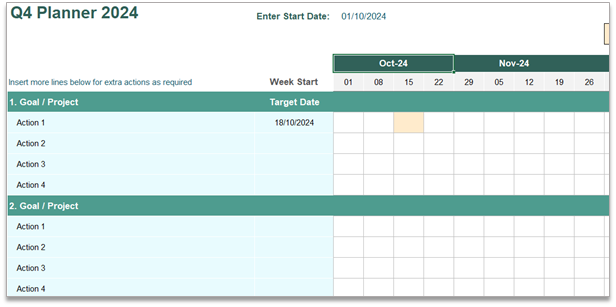Productivity expert Moira Dunne from BeProductive on how to close out your business year successfully.
For many businesses, the last two months of the year represent their busiest period. The day-to day operational work ramps up. Year-end targets need to be met. Projects need to be completed. And what about planning for next year?
When time is tight and workloads are heavy, it is important to prioritise. With clear priorities everyone can make better decisions about how to use their precious time.
“Productive organisations are crystal clear about their priorities”
Here are three practical tips to help you achieve a strong finish to the year.
- Review Your Goals & Priorities
- Make a Realistic Plan
- Track Your Progress
1. Review Your Goals & Priorities
Start by reviewing the goals set for 2024. Identify what is outstanding and add anything new. Then set your priorities by considering:
- What needs to be achieved by the end of this year?
- What can be moved to Q1 2025
This is a key question. When resources and time are limited, it’s time to ruthlessly prioritise so you focus on the work that moves the needle for you or the business.
“‘Saying No’ is one of the hardest skills in business. But it can be the right decision if the request is a lower priority than your planned work which is a priority”
Productive organisations are crystal clear about their priorities. Using a model such as ‘Must Do, Should Do, Could Do’ allows them categorise the work to be done, so that all employees know the correct decisions to make.
What pieces of work fall into each of the 3 categories needs to be agreed within a business or individual teams. Here is a guideline:
A. Must Do – High Priority
This can include work that:
- Is business or role critical
- Relates to performance metrics
- Delivers for key stakeholders
B. Should Do – Medium Priority
This can include work that:
- Is not critical but would add value
- May not be requested but would be good for the business
- May be important but not the priority right now
C. Could Do – Low Priority
This can include work that:
- Can be described as ‘” nice to have”
- Is not essential or core
- May be a someone’s ‘Passion Project’ but not critical within their role
When capacity is tight, a focus on the ‘Must Do’ goals and tasks will make the biggest impact.
When there is more capacity or time, you may have an opportunity to work on some of the Should and Could Do priorities.
2. Make a Realistic Plan
Now it is important to break down the high-level goal or project into smaller sub-goals and lists of tasks, so that there is clarity about what actually needs to be done.
A team brainstorming session can achieve this drill-down by engaging people for their ideas. Capture the information in a Team Planner that can be shared for all to collaborate as they complete their work. Assign a person to each task and agree the target completion time. You can access an Excel Q4 Team Planner Template from our website here
Now the work can be included in weekly team plans and individual To-Do lists. But be realistic about how much time is available for “planned, proactive” work amongst the day-to-day operations of the business. It is better to under-plan than over-plan as the latter is not only unrealistic but demotivating
3. Track Your Progress
As the work gets done, track progress by capturing completion dates. If the target dates are being missed, understand the reasons why. Without this insight you can’t achieve the goal.
Do the priorities need to be reviewed? Has new work emerged that is competing for people’s time?
Finding Time for Planned Priority Work
We all know that our time can disappear very easily. So it is important to proactively protect it for the ‘Must Do’ work. Otherwise, other things (and people!) will steal it away.
Block time in your diary at the start of each week for your priority work. And then, do what you can to stick to it. Don’t give this time away easily when other things crop up. You can also try to gain back time with these ideas:
- Keep meeting time short (45 minutes max)
- Decline non-essential meetings
- Say No to lower priority work
‘Saying No’ is one of the hardest skills in business. But it can be the right decision if the request is a lower priority than your planned work which is a priority. Explain why you are saying no and suggest an alternative time or solution. In effect, you will be saying yes but on your own terms.
Find What Works for You
With all our productivity tips we recommend that you: 1) tweak them to find what works best for you and your business. Then I hope you have a strong end to 2024.
If you enjoyed this article, why not check out all our Productivity, Wellbeing and Time Management resources here
-
Bank of Ireland is welcoming new customers every day – funding investments, working capital and expansions across multiple sectors. To learn more, click here
-
Listen to the ThinkBusiness Podcast for business insights and inspiration. All episodes are here. You can also listen to the Podcast on:
-
Spotify
-
SoundCloud
-
Apple







